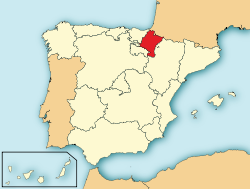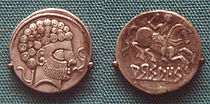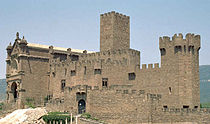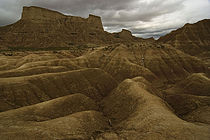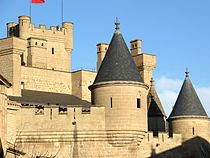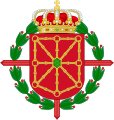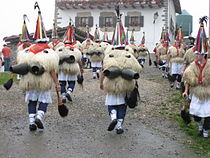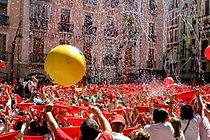- Navarre
-
"Navarra" redirects here. For the wine region, see Navarra (DO). For other uses, see Navarre (disambiguation).
Navarra
Nafarroa (Basque)
Navarra (Spanish)— Autonomous Community — Chartered Community of Navarre
Nafarroako Foru Erkidegoa (Basque)
Comunidad Foral de Navarra (Spanish)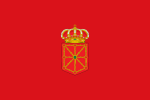
Flag
Coat of armsMap of Navarra Coordinates: 42°49′N 1°39′W / 42.817°N 1.65°WCoordinates: 42°49′N 1°39′W / 42.817°N 1.65°W Country Spain Capital Pamplona Government - President Yolanda Barcina (UPN) Area(2.2% of Spain; Ranked 11th) - Total 10,391 km2 (4,012 sq mi) Population (2007) - Total 620,337 - Density 59.7/km2 (154.6/sq mi) - Pop. rank 15th - Percent 1.3% of Spain ISO 3166-2 NA Official languages Spanish and Basque Statute of Autonomy August 16, 1982 Parliament Cortes Generales Congress seats 5 (of 350) Senate seats 5 (of 264) Website Gobierno de Navarra Navarre (Spanish: Navarra, IPA: [naˈβara]; Basque: Nafarroa, IPA: [nafaroa]), officially the Chartered Community of Navarre (Spanish: Comunidad Foral de Navarra; Basque: Nafarroako Foru Erkidegoa) is an autonomous community in northern Spain, bordering the Basque Country, La Rioja, and Aragon in Spain and Aquitaine in France. The capital is the city of Pamplona.
Contents
History
During the time of the Roman Empire, the territory of the province was inhabited by the Vascones, a pre-Roman tribe who populated the southern slopes of the Pyrenees. In the northern, mountaineous areas the Vascones escaped large-scale Roman settlement but not so in the flatter areas to the south which were amenable to large-scale Roman farming.
The area was never fully subjugated either by the Visigoths or by the Moors. In AD 778, the Basques defeated a Frankish army in the Battle of Roncevaux Pass. Two generations later, in 824, the chieftain Iñigo Arista was chosen King of Pamplona, laying a foundation for the later Kingdom of Navarre. That kingdom reached its zenith during the reign of Sancho III of Navarre and covered the area of the present-day Navarre, Basque country, and La Rioja, together with parts of modern Cantabria, Castile and León, and Aragon.
After Sancho III died, the Kingdom of Navarre was divided between his sons and never fully recovered its importance. The army of Navarre fought beside other Christian Spanish kingdoms in the decisive battle of Las Navas de Tolosa in 1212, after which the Muslim conquests on the Iberian Peninsula were slowly reduced to a small territory in the south.
In AD 1515, the bulk of Navarre south of the Pyrenees—Upper Navarre—was at last absorbed into the incipient Kingdom of Spain but retained some exclusive rights. The small portion of Navarre lying north of the Pyrenees—Lower Navarre—later came under French rule when its Huguenot sovereign became King Henry IV of France; with the declaration of the French Republic and execution of Louis XVI, the last King of France and Navarre, the kingdom was merged into a unitary French state.
Community
The community ceremonies, education, and social services, together with housing, urban development, and environment protection policies are under the responsibility of its own institutions.
Unlike other autonomous communities of Spain (but like the Basque Country), Navarre has almost full responsibility for collecting and administering taxes which must follow the overall guidelines established by the Spanish government but may have some minor differences.
Geography and Climate
Navarre is made up of 272 municipalities and has a total population of 601,874 (2006), of which approximately one-third live in the capital, Pamplona (195,769 pop.), and one-half in the capital's metropolitan area (315,988 pop.). There are no other large municipalities in the region. The next largest are Tudela (32,802), Barañáin (22,401), Burlada (18,388), Estella - Lizarra (13,892), Zizur Mayor (13,197), Tafalla (11,040), Villava/Atarrabia (10,295), and Ansoáin (9,952).
Despite its relatively small size, Navarre features stark contrasts in geography, from the Pyrenees mountain range that dominates the territory to the plains of the Ebro river valley in the south. The highest point in Navarre is Hiru Erregeen Mahaia, with an elevation of 2,428 metres (7,965 feet). Other important mountains are Txamantxoia, Kartxela, the Larra-Belagua Massif, Sierra de Alaiz, Untzueko Harria, Sierra de Leyre, Sierra del Perdón, Montejurra, Ezkaba, Monte Ori, Sierra de Codés, Urbasa, Andia and the Aralar Range.
Cultural heritage
Navarre is a mixture of its Vasconic tradition, the Trans-Pyrenean influx of people and ideas and Mediterranean influences coming from the Ebro. The Ebro valley is amenable to wheat, vegetables, wine, and even olive trees as in Aragon and La Rioja. It was a part of the Roman Empire, inhabited by the Vascones, later controlled on its southern fringes by the Muslims Banu Qasi, whose authority was taken over by the taifa kingdom of Tudela in the 11th century.
During the Reconquista, Navarre gained little ground at the expense of the Muslims. Starting in the 11th century, the Way of Saint James grew a very important milestone for the territory and source of European cultural influence. Gascons and Occitanians altogether from beyond the Pyrenees (called Franks[citation needed]) were granted privileges to foster their settlement in Navarrese towns, causing them to bring along their craft, culture and Romance languages.
Jews and Muslims couldn't escape the drastic measures imposed on them and were expelled for the most part in a process spanning half a century at the end of the 15th century and start of the 16th, definitely after Navarre was seized by Castile-Aragon.
Energy policy
Navarre leads Europe in its use of renewable energy technology and was planning to reach 100% renewable electricity generation by 2010. By 2004, 61% of the region's electricity was generated by renewable sources consisting of 43.6% from 28 wind farms, 12% from over 100 small-scale water turbines, and 5.3% from 2 biomass and 2 biogas plants. In addition, the region had what was then Spain's largest photovoltaic power plant at Montes de Cierzo de Tudela (1.2 MWp capacity) plus several hundred smaller photovoltaic installations.
Developments since 2004 have included further photovoltaic plants at Larrión (0.25 MWp)[1] and another at Castejón (2.44 MWp), also once the largest in Spain.[2]
Languages
Spanish is the official language in Navarre, together with Basque, which also has official status in the Basque-speaking area.[3] The northwestern part of the community is largely Basque-speaking, while the southern part is almost entirely Spanish-speaking, aside from Fitero. The capital, Pamplona, is in the mixed region. Navarre is divided into three parts linguistically: regions where Basque is widespread (the Basque-speaking area), regions where Basque is present (the mixed region), and regions where Basque is absent (the Spanish-speaking area).[4]
Heraldry
In modern history, Navarre had had three different official designs before moving to the current design. The arms were changed with every change of regime.
See also
- Basque language
- Euskadi
- Kingdom of Navarre
- Kings of Navarre
- Lower Navarre
- Parliament of Navarre
- Renewable energy in the European Union
References
External links
- Official website (in Basque/English/French/Spanish)
- History of Navarre
- (LAS BARDENAS, CAVERN, GROTTE VALTIERRA, CUEVAS DE VALTIERRA)
- Bardenas Reales desert (Navarra)
- Northern Spanish region leads way on renewable energy
- Navarra: Electricity from renewable energy sourcesPDF (211 KB)
- Euskara Kultur Elkargoa-Basque Cultural Foundation
- Navarra en Fotos[dead link]
Autonomies of Spain Autonomous communities Andalusia · Aragon · Asturias · Balearic Islands · Basque Country · Canary Islands · Cantabria · Castile-La Mancha · Castile and León · Catalonia · Extremadura · Galicia · Madrid · Murcia · Navarre · La Rioja · Valencian Community
Autonomous cities Plazas de soberanía Provinces of Spain A Coruña · Álava · Albacete · Alicante · Almería · Asturias · Ávila · Badajoz · Balearic Islands · Barcelona · Biscay · Burgos · Cáceres · Cádiz · Cantabria · Castellón · Ciudad Real · Córdoba · Cuenca · Girona · Granada · Guadalajara · Gipuzkoa · Huelva · Huesca · Jaén · Las Palmas · León · Lleida · Lugo · Madrid · Málaga · Murcia · Navarre · Ourense · Palencia · Pontevedra · La Rioja · Salamanca · Segovia · Seville · Soria · Tarragona · Santa Cruz de Tenerife · Teruel · Toledo · Valencia · Valladolid · Zamora · Zaragoza

Traditional provinces of the Basque Country Southern Basque Country : Basque Autonomous Community (Gipuzkoa · Álava · Biscay) · Navarre
Northern Basque Country : Labourd · Lower Navarre · Soule Categories:
Categories:- Navarre
- Autonomous communities of Spain
- Provinces of Spain
- NUTS 2 statistical regions of the European Union
- States and territories established in 1982
- Regions of Europe with multiple official languages
Wikimedia Foundation. 2010.

